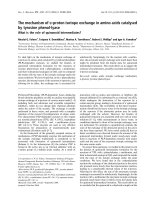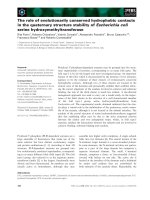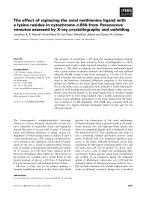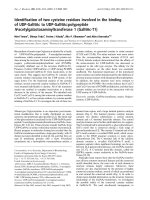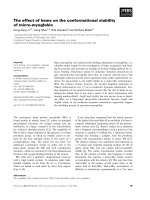Báo cáo khoa học: "The Effect of Two Different Oxytetracycline Treatments in Experimental Ehrlichia phagocytophila Infected Lambs" ppt
Bạn đang xem bản rút gọn của tài liệu. Xem và tải ngay bản đầy đủ của tài liệu tại đây (81.33 KB, 8 trang )
Stuen S, Bergström K: The effect of two different oxytetracycline treatments in ex-
perimental Ehrlichia phagocytophila infected lambs: Acta vet. scand. 2001, 42, 339-
346. – The effect of 2 different oxytetracycline treatments in acute E. phagocytophila in-
fected lambs was investigated. Twenty 5-month-old lambs of the Dala and Rygja breeds
were used. Ten lambs were inoculated intravenously with a stabilate of an ovine E.
phagocytophila strain. On the third day of fever, 4 lambs were given long-acting oxyte-
tracycline (Terramycin prolongatum vet
®
, Pfizer) (20 mg/kg) intramuscularly and an-
other 4 lambs were given short-acting oxytetracycline (Terramycin vet
®
, Pfizer) (10
mg/kg) intravenously for 5 consecutive days. The lambs were examined for the presence
of Ehrlichia infection by blood smear evaluation, polymerase chain reaction (PCR) and
antibody titre against E. equi. One month after the last antibiotic treatment, 250 ml cit-
rate blood from each of these lambs were inoculated into each of 10 susceptible lambs,
which were observed during the following 6 weeks. The results indicate that oxytetra-
cycline given in the acute stage of the infection may effectively teminate the develop-
ment of fever, rickettsemia and weight reduction in E. phagocytophila infected lambs.
No difference was observed between the 2 treatment groups. However, at least 3 of 8 an-
tibiotic treated lambs (37.5%) were still infected with granulocytic Ehrlichia 3 months
after treatment.
sheep; antibodies; Ehrlichia equi; persistence; tick-borne fever.
Acta vet. scand. 2001, 42, 339-346.
Acta vet. scand. vol. 42 no. 3, 2001
The Effect of Two Different Oxytetracycline
Treatments in Experimental Ehrlichia phagocytophila
Infected Lambs
By S. Stuen
1
and K. Bergström
2
1
Norwegian School of Veterinary Science, Department of Sheep and Goat Research, Sandnes, Norway and
2
National Veterinary Institute, Department of Bacteriology, Uppsala, Sweden.
Introduction
Granulocytic Ehrlichia infections are observed
in an increasing number of species of animals
in Europe (Brouqui 1999). The tetracycline
group has so far been the recommended antibi-
otics in treatment of granulocytic ehrlichiosis in
both animals and man (Woldehiwet & Scott
1993, Dumler 1996). Tetracycline has been ad-
ministered to cattle and sheep with Ehrlichia
phagocytophila infection and has resulted in a
rapid resolution of the fever (Venn & Woodford
1956, Foggie & Allison 1960, Brodie et al.
1988). In addition, successful field use of long-
acting tetracycline as a prophylatic measure
against tick-borne fever (TBF) and tick
pyaemia in lambs has been reported (Brodie et
al. 1986).
One dose of short-acting oxytetracycline re-
sults in an abrupt fall in the temperature in TBF
infected lambs and relapses are common (Scott
1976). However, a report by Brodie et al. (1988)
indicates that relapses do not occur after long-
acting oxytetracycline treatment. The purpose
of this study was to investigate the effect of 2
different oxytetracycline treatments to clear the
experimentally infected lambs from E. phago-
cytophila infection.
Materials and methods
Twenty 5 months old lambs of the Dala and
Rygja breeds were used. The mean bodyweight
of the lambs was approximately 40 kg at the
start of the study. None of the animals had pre-
viously been on Ixodes ricinus infested pasture
and all animals were kept indoors during the ex-
periment. Ten lambs were inoculated intra-
venously on day 0 with 0.5 ml (containing ap-
proximately 1.3×10
6
infected cells pr. ml) of a
whole blood dimethyl sulphoxide stabilate of
an E. phagocytophila strain originally isolated
from a sheep (Stuen et al. 1992). On the third
day of fever, day 6 post inoculation, 4 lambs
(LAT-group) were given long-acting oxytetra-
cycline (Terramycin prolongatum vet
®
, Pfizer)
(20 mg/kg) intramuscularly and another 4
lambs (T-group) were given short-acting oxyte-
tracycline (Terramycin vet
®
, Pfizer) (10 mg/kg)
intravenously for 5 consecutive days. Six weeks
after the primary inoculation, the infected
lambs were treated intramuscularly with 2 mg
dexamethasone (Vorenvet vet
®
, Boehringer In-
gelheim) daily for 4 days. On the first day post
treatment, each of 10 susceptible lambs was in-
oculated intravenously with 250 ml citrate-
blood taken directly from the previously inocu-
lated animals; each of the 10 lambs receiving
blood from only one donor lamb. The clinical,
haematological and serological reactions of the
recipient lambs were observed during the fol-
lowing 6 weeks.
Rectal temperatures were measured daily in all
lambs at the same hour in the morning during
the whole experimental period of 3 months. In
addition, the temperatures were also measured
2 h and 6 h after oxytetracycline treatment in
the infected lambs. The incubation period was
defined as the period between inoculation and
the first day of fever (≥40.0°C), and the dura-
tion of fever was recorded as the number of
days with a body temperature of at least 40.0°C.
EDTA-blood samples were collected on days 0,
2-10, 14 and thereafter weekly for over 2
months. In addition, EDTA-blood samples were
collected 2 h and 6 h after oxytetracycline treat-
ment in the infected lambs and also if the rectal
temperature in any individual lamb was above
40°C. Hematological values including total and
differential leucocyte counts were determined
electronically (Technicon H1
®
, Miles Inc.,
USA) and blood smears were prepared and
stained with May-Grünwald Giemsa. Four hun-
dred neutrophils were examined on each smear
by microscopy and the number of these cells
containing Ehrlichia inclusions was recorded.
In addition, these blood samples were also
tested for granulocytic Ehrlichia infection by a
polymerase chain reaction (PCR) technique ac-
cording to Stuen & Olsson Engvall (1999).
Serum samples from all lambs were collected
each week during the experimental period. An
indirect immunofluorescence antibody assay
(IFA) was used to determine the antibody titre
to E. equi (Artursson et al. 1999). Briefly, 2-
fold dilutions of sera were added to slides pre-
coated with E. equi antigen (Protatek Interna-
tional and Organon Teknika). Bound antibodies
were visualized by fluorescein-isothiocyanate
(FITC)-conjugated rabbit-anti-sheep immu-
noglobulin (Cappel, Organon Teknika). Sera
were screened for antibodies at dilution 1:40. If
positive, the serum was further diluted and
retested. A titre of 1.6 (log
10
reciprocal of 1:40)
or more was regarded as positive.
All experimental lambs were weighed weekly.
Statistical calculations were done by Statistix
®
,
version 4.0 (Analytical Software).
Results
The E. phagocytophila inoculated lambs
showed infected neutrophils on day 3 (Table 1)
and fever on day 4. On the day after antibiotic
treatment (day 7) the temperature had dropped
to preinfected levels (Table 2). Three of the
oxytetracycline treated lambs showed neutrope-
340 S. Stuen & K. Bergström
Acta vet. scand. vol. 42 no. 3, 2001
nia (<0.7×10
6
cells/l) for 2 days, i.e. on days 9
and 10; one lamb in the LAT-group and 2 in the
T-group, respectively. In contrast, the 2 infected
control lambs were neutropenic for 8 days, i.e.
on days 12-20.
No difference in clinical reaction was observed
between the lambs treated once with long-act-
ing or for 5 days with short-acting oxytetracy-
cline. The mean body temperature was reduced
significantly 6 h after oxytetracycline treatment
(Student´s paired t-test, p<0.03) (Table 2). No
relapse of fever was observed in the treated
lambs during the rest of the experimental pe-
riod, except in one lamb at day 53.
The number of infected neutrophils (rickett-
semia) in the antibiotic treated lambs was re-
duced compared with the control lambs one day
after oxytetracycline treatment. A significant
reduction (Student´s paired t-test, p<0.0005) in
the absolute number of infected neutrophils
was recorded 2 h after oxytetracycline treat-
ment (Table 2). In addition, the morulae in
stained blood smears from oxytetracycline
treated lambs were more dense and dark blue
compared to untreated controls the first days af-
ter treatment.
Infected neutrophils were observed in all lambs
2 days after antibiotic treatment, but were ab-
sent 4 days after treatment. However, PCR anal-
ysis showed that 2 lambs were positive also on
that day. Ehrlichia infection was not detected in
the peripheral blood of the treated lambs during
the next month, neither by blood smear exami-
nation nor by PCR analysis.
When blood from previously infected and an-
tibiotic treated lambs was inoculated into recip-
Treatment of Ehrlichia infection 341
Acta vet. scand. vol. 42 no. 3, 2001
Table 1. The mean percentage of infected neutrophils in 10 E. phagocytophila infected lambs. Eight of the
lambs were treated with antibiotics on day 6 after the primary inoculation; 4 lambs (LAT-group) were treated
with long-acting oxytetracycline (20 mg/kg), and 4 lambs (T-group) were treated with short-acting oxytetracy-
cline (10 mg/kg) for 5 consecutive days. Two lambs were untreated controls.
Day 0 Day 3 Day 4 Day 5 Day 6 Day 7 Day 8 Day 9*
LAT-group 0 <1 3.1 67.7 54.7 12.7 1.5 <1 #
T-group 0 <1 11.4 65.7 58.5 13.0 1.8 <1 #
Controls 0 <1 4.8 55.5 49.0 51.0 46.5 33.5
# one lamb was found infected.
* one lamb in each of the treated groups was found positive by PCR analysis on day 10.
Table 2. Mean temperature and percentage and absolute number of infected neutrophils (±SD) in 8 E. phago-
cytophila infected lambs at different hours after oxytetracycline treatment, and in 2 untreated control lambs. The
lambs were given either long-acting oxytetracycline or 5 days short-acting oxytetracycline.
0 hour 2 hours 6 hours 24 hours
Treated Control Treated Control Treated Control Treated Control
Temperature (°C) 41.23 41.40 41.33 41.55 40.53 41.60 39.11 41.40
±0.198 ±0.100 ±0.254 ±0.150 ±0.299 ±0.200 ±0.417 ±0.200
% infected neutrophils 56.6 52.5 38.1 49.5 34.4 54.0 12.9 46.5
±4.24 ±4.50 ±3.79 ±8.50 ±3.50 ±2.00 ±2.47 ±7.00
Number of infected 1.58 1.55 1.04 1.53 1.06 1.71 0.33 1.96
Neutrophils (10
9
cells/l) ±0.451 ±0.410 ±0.366 ±0.280 ±0.357 ±0.535 ±0.131 ±0.100
ient lambs 42 days after primary inoculation
and one month after oxytetracycline treatment,
2 of 8 recipient lambs reacted with fever, rick-
ettsemia and seroconversion. One of these
lambs had been inoculated with blood from one
lamb in the LAT-group and the other with blood
from the T-group. The incubation period was 4
and 5 days, respectively, and a positive titre was
observed within 14 days. However, rickettsemia
or seroconversion was not observed in the other
recipient lambs. In contrast, the 2 control lambs
were found infected with E. phagocytophila on
day 42 by blood inoculation.
In additon, one donor lamb in the original T-
group that was found Ehrlichia negative on the
day of blood transfusion by blood smear exam-
ination, PCR analysis, and blood inoculation,
reacted with fever and rickettsemia 11 days
later (maximum temperature: 41.5°C, duration
of fever: 5 days, maximum rickettsemia: 73%,
nadir of neutropenia: 0.51 G/l, duration of neu-
tropenia: 3 days). The antibody titre increased
from 1:40 to 1:1280 within 14 days, but no
weight reduction was observed. None of the
other inoculated and antibiotic treated lambs re-
acted with fever and rickettsemia as a result of
cortisone treatment and blood transfusion, nor
did the control lambs.
The antibody response to granulocytic Ehr-
lichia is shown in Fig. 1. Apart for one lamb in
the LAT-group, all inoculated and oxytetracy-
cline treated lambs reacted with seroconver-
sion. No difference in the antibody titre was ob-
served between the lambs in the 2 antibiotic
342 S. Stuen & K. Bergström
Acta vet. scand. vol. 42 no. 3, 2001
Figure 1. Antibody titre (log
10
) to E. equi in 10 lambs inoculated with E. phagocytophila on day 0. Eight lambs
were treated with oxytetracycline on day 6, while 2 lambs were untreated controls. The treated lambs were ei-
ther given long-acting tetracycline or 5 days short-acting tetracycline. One of the treated lambs did not sero-
convert (not shown)
᭜ Treated and still with rickettsemia 1-3 months after treatment (3 lambs)
Treated and without rickettsemia 1-3 months after treatment (4 lambs)
$ only 3 lambs * only 2 lambs
᭝ Infected controls (2 lambs)
treated groups (data not shown). Four weeks af-
ter the primary inoculation, the mean reciprocal
antibody (log
10
) titre was 2.20 ± 0.360 and 2.96
± 0.151 in the treated and untreated control
group, respectively.
One month after antibiotic treatment, 6 out of 8
lambs had a positive antibody titre, while 2
months later only 5 of these lambs had a posi-
tive titre. At that time, 3 of these 5 positive
lambs and the control lambs had a mean anti-
body titre of 2.41 ± 0.142 and 2.35 ± 0.151, re-
spectively, and were also found infected by
blood smear examination and PCR analysis. In
contrast, the 2 other seropositive lambs had a
mean antibody titre of 1.62 ±0.00 three months
after the primary infection, and were, together
with the seronegative lambs, not found infected
with E. phagocytophila at that time (Fig. 1).
The weekly weight gain in the infected and an-
tibiotic treated lambs was reduced by less than
0.8 kg between the first and second week after
the primary infection. In contrast, the weekly
weight gain in the untreated control lambs was
reduced by 5.5 kg in the same period. Three
months after the primary infection the total
weight gain had been 7.3 ± 2.86 kg and 4.0 ±
0.00 kg in the oxytetracycline treated lambs and
untreated controls, respectively.
Discussion
In the acute E. phagocytophila infected lambs,
the temperature returned to normal within 24 h
after oxytetracycline treatment. However, the
temperature had already dropped significantly 6
h after treatment. Earlier investigations on E.
phagocytophila infected cattle have shown that
the temperature drops to normal levels 12 h af-
ter intravenous oxytetracycline treatment (Venn
& Woodford 1956). In TBF-infected dwarf
goats the temperature dropped 3 hours after
oxytetracycline treatment and was normalised
within 6 h (Anika et al. 1986).
Pyknotic inclusions were found the first days
after antibiotic treatment. This is in accordance
with an earlier study in goats where pyknotic
spots were observed within infected cells ap-
proximately 8 h after treatment with oxytetra-
cycline (Anika et al. 1986).
In the present study, rickettsemia was signifi-
cantly reduced within 2 h after the treatment.
By PCR analysis 2 of the 8 lambs were found
infected 4 days after the antibiotic treatment
had started. The sensitivity of the PCR tech-
nique may have been improved by use of a
nested PCR (Barlough et al. 1996). However,
nested PCR was not available in this study.
No difference in clinical, hematological or rick-
ettsemia reactions were observed between the 2
treatment groups. The mode of action of tetra-
cyclines is the inhibition of bacterial protein
synthesis. A serum concentration of 0.5 µg/ml
has been taken as a minimum inhibitory thera-
peutic concentration of oxytetracycline for
most susceptible pathogens (Davey et al. 1985,
Escudero et al. 1994). According to the manu-
facturer´s recommendation, this plasma con-
centration is maintained for approximately 84 h
in sheep after intramuscular injection with
long-acting oxytetracycline (20 mg/kg). Simi-
larly, after intravenous administration of a dose
of 10 mg/kg in sheep, this plasma concentration
is maintained for 24 h. In the present trial, the
inhibitory concentration may therefore have
been maintained for at least 6 days in the lambs
given short-acting oxytetracycline. The in-
hibitory therapeutic concentration of the rick-
ettsiae E. phagocytophila is, however, not
known.
The results demonstrate that oxytetracycline is
efficient against E. phagocytophila in sheep as
previously shown by Brodie et al. (1988). How-
ever, oxytetracycline could not totally clear the
infection from all lambs. At least 3 of 8 lambs
were still infected with E. phagocytophila one
month after oxytetracycline treatment. The effi-
cacy of tetracycline derivatives to eliminate
Treatment of Ehrlichia infection 343
Acta vet. scand. vol. 42 no. 3, 2001
other Ehrlichia infections, for instance an E.
canis infection, remains controversial. One ex-
perimental study indicates that 6 weeks of daily
doxycycline treatment was not sufficient to
clear E. canis from subclinically infected dogs
(Harrus et al. 1998).
Two hundred and fifty ml blood from one lamb
was not infective on the day of blood transfu-
sion, although the lamb showed infection in the
circulating blood 11 days later. Earlier study on
experimental E. phagocytophila infection in
lambs has shown that one infected neutrophil is
enough to transmit the infection intravenously
(Stuen & Artursson 2000). The present result
therefore indicates that circulating blood is not
always infective in persistently TBF infected
lambs, and is in accordance with earlier obser-
vations that infection in the peripheral blood
varies in E. phagocytophila infected animals
(Foggie 1951, Stuen et al. 1998).
This result also demonstrates the diagnostic
problems in verifying a granulocytic Ehrlichia
infection in persistently infected lambs, since
both stained blood smear investigation, PCR
analysis of peripheral blood and blood inocula-
tion trials could be negative. In addition, stress
induced by cortisone treatment and heavy blood
losses was not enough to cause relapses of fever
in 4 of 5 infected lambs, as also observed ear-
lier (Stuen et al. 1998). Sheep should therefore
be examined several times before they eventu-
ally may be declared infected or not with gran-
ulocytic Ehrlichia.
Except for one lamb, all oxytetracycline treated
lambs reacted with a positive antibody titre
against E. equi. Strong serological cross-reac-
tions between E. equi, E. phagocytophila and
the agent causing human granulocytic ehrli-
chiosis (HGE) have been reported (Dumler et
al. 1995, Nicholson et al. 1997, Pusterla et al.
1997). The sensitivity of the present test may
have been increased by use of a more proper
antigen (Bjoersdorff et al. 1999, Walls et al.
1999), but unfortunately E. phagocytophila was
not available for use as antigen in this study.
Although few lambs are involved in this study,
the present results may indicate that the anti-
body titres are higher in persistently infected
lambs than in lambs that have been cleared of
the infection. Similar observations have been
reported in E. equi infection in horses (Nyindo
et al. 1978) and in E. canis infection in dogs
(Iqbal & Rikihisa 1994). However, the antibody
titre is not a good criterion for assessing recov-
ery from the persistent state of the E. phagocy-
tophila infection, both due to individual varia-
tion in immune response and persistence of
antibody titre in infected lambs (Scott 1981,
Paxton & Scott 1989, Stuen et al. 1998). Earlier
studies also show that the IFA-test can not be
used in assessing clearance of E. canis after an-
tibiotic treatment, since dogs remain IFA posi-
tive for months after clearance of the organism
(Iqbal & Rikihisa 1994, Harrus et al. 1998).
In the present investigation, the oxytetracycline
treated lambs gained more weight than un-
treated lambs and were 3.3 kg heavier than the
inoculated and untreated controls 3 months af-
ter the primary infection. No statistical analysis
could be done on this material due to a low
number of animals. However, this result is in
accordance with earlier observations in both
calves (Brodie et al. 1986, Cranwell 1990) and
lambs (Stuen et al. 1992).
In conclusion, the present study indicates that
oxytetracycline given in the acute stage of the
infection could effectively abrupt the develop-
ment of fever, rickettsemia and weight reduc-
tion in E. phagocytophila infected lambs. How-
ever, some lambs were still infected with
granulocytic Ehrlichia after 5 days of oxytetra-
cycline treatment. Further investigations are
needed to clarify the appropriate regimen using
oxytetracycline to clear lambs from an E.
phagocytophila infection.
344 S. Stuen & K. Bergström
Acta vet. scand. vol. 42 no. 3, 2001
References
Artursson K, Gunnarsson A, Wikström U-B, Olsson
Engvall E: A serological and clinical follow-up
in horses with confirmed equine granulocytic
ehrlichiosis. Equine Vet. J. 1999, 31, 473-477.
Anika SM, Nouws, JFM, Van Gogh H, Nieuwenhuijs
J, Vree TB, Van Miert ASJPAM: Chemotherapy
and pharmacokinetics of some antimicrobial
agents in healthy dwarf goats and those infected
with Ehrlichia phagocytophila (tick-borne fever).
Res. vet. Sci. 1986, 41, 386-390.
Barlough JE, Madigan JE, DeRock E, Bigornia L:
Nested polymerase chain reaction for the detec-
tion of Ehrlichia equi genomic DNA in horses
and ticks (Ixodes pacificus). Vet. Parasitol. 1996,
63, 319-329.
Bjoersdorff A, Brouqui P, Eliasson I, Massung RF,
Wittesjö B, Berglund J: Serological evidence of
Ehrlichia infection in Swedish Lyme borreliosis
patients. Scand. J. infect. Dis. 1999, 31, 51-55.
Brodie, TA, Holmes PH, Urquhart GM: Some as-
pects of tick-borne diseases of British sheep. Vet.
Rec. 1986, 118, 415-418.
Brodie TA, Holmes PH, Urquhart GM: Prophylactic
use of long-acting tetracycline against tick-borne
fever (Cytoecetes phagocytophila) in sheep. Vet.
Rec. 1988, 122, 43-44.
Brouqui P: Ehrlichiosis in Europe. In: Raoult D,
Brouqui P (eds.): Rickettsiae and rickettsial dis-
eases at the turn of the third millennium. Elsevier,
Paris, 1999: 220-232.
Cranwell MP: Efficacy of long-acting oxytetracy-
cline for the prevention of tick-borne fever in
calves. Vet. Rec. 1990, 126, 334-336.
Davey LA, Ferber MT, Kaye B: Comparison of the
serum pharmacokinetics of long-acting and a
conventional oxytetracycline injection. Vet. Rec.
1985, 117, 426-429.
Dumler JS: Human ehrlichiosis: Clinical, laboratory,
epidemiologic, and pathologic considerations. In:
Kazár J, Toman R (eds.): Rickettsiae and rick-
ettsial diseases, Veda, Bratislava, 1996: 287-302.
Dumler JS, Asanovich KM, Bakken JS, Richter P,
Kimsey R, Madigan JE: Serologic cross-reac-
tions among Ehrlichia equi, Ehrlichia phagocy-
tophila, and human granulocytic Ehrlichia. J.
clin. Microbiol. 1995, 33, 1098-1103.
Escudero E, Carceles CM, Serrano JM: Pharmacoki-
netics of oxytetracycline in goats: modifications
induced by long-acting formulation. Vet. Rec.
1994, 135, 548-552.
Foggie A: Studies on the infectious agent of tick-
borne fever in sheep. J. Path. Bact. 1951, 63, 1-
15.
Foggie A, Allison CJ: A note on the occurrence of
tick-borne fever in cattle in Scotland with com-
parative studies of bovine and ovine strains of the
organism. Vet. Rec. 1960, 72, 767-770.
Harrus S, Waner T, Aizenberg I, Bark H: Therapeutic
effect of doxycycline in experimental subclinical
canine monocytic ehrlichiosis: evaluation of a 6-
week course. J. clin. Microbiol. 1998, 36, 2140-
2142.
Iqbal Z, Rikihisa Y: Reisolation of Ehrlichia canis
from blood and tissues of dogs after doxycycline
treatment. J. clin. Microbiol. 1994, 32, 1644-
1649.
Nicholson WL, Comer JA, Sumner JW, Gingrich-
Baker C, Coughlin RT, Magnarelli LA, Olson JG,
Childs JE: An indirect immunofluorescence as-
say using a cell culture-derived antigen for detec-
tion of antibodies to the agent of human granulo-
cytic ehrlichiosis. J. clin. Microbiol. 1997, 35,
1510-1516.
Nyindo MBA, Ristic M, Lewis GE, Huxsoll,DL,
Stephenson EH: Immune response of ponies to
experimental infection with Ehrlichia equi.
Amer. J. vet. Res. 1978, 39, 15-18.
Paxton EA, Scott GR: Detection of antibodies to the
agent of tick-borne fever by indirect immunoflu-
orescence. Vet. Microbiol. 1989, 21, 133-138.
Pusterla N, Wolfensberger C, Gerber-Bretscher R,
Lutz H: Comparison of indirect immunofluores-
cence for Ehrlichia phagocytophila and Ehrlichia
equi in horses. Equine Vet. J. 1997, 29, 490-492.
Scott GR: Annual report, Centre of Tropical Veteri-
nary Medicine, Edinburgh, 1976, 20.
Scott GR: Annual report, Centre of Tropical Veteri-
nary Medicine, Edinburgh, 1981, 18.
Stuen S, Artursson K: Effects of the dose of Ehrlichia
phagocytophila on the severity of experimental
infections in lambs. Vet. Rec. 2000, 146, 669-672
Stuen S, Hardeng F, Larsen HJ: Resistance to tick-
borne fever in young lambs. Res. Vet. Sci. 1992,
52, 211-216.
Stuen S, Olsson Engvall E, Artursson K: Persistence
of Ehrlichia phagocytophila infection in lambs in
relation to clinical parameters and antibody re-
sponses. Vet. Rec. 1998, 143, 553-555.
Stuen S, Olsson Engvall E: Ehrlichia phagocytophila
infection in lambs as a post mortem diagnosis. In:
Raoult D, Brouqui P (eds.): Rickettsiae and rick-
ettsial diseases at the turn of the third millenium.
Elsevier, Amsterdam, 1999: 406-411.
Treatment of Ehrlichia infection 345
Acta vet. scand. vol. 42 no. 3, 2001
Venn JAJ, Woodford MH: An outbreak of tick-borne
fever in bovines. Vet. Rec. 1956, 68, 132-133.
Walls JJ, Aguero-Rosenfeld M, Bakken JS, Goodman
JL, Hossain D, Johnson RC, Dumler JS: Inter-
and intralaboratory comparison of Ehrlichia equi
and human granulocytic ehrlichiosis (HGE)
agent strains for serodiagnosis of HGE by the im-
munofluorescent-antibody test. J. clin. Microbiol.
1999, 37, 2968-2973.
Woldehiwet Z, Scott GR: Tick-borne (pasture) fever.
In: Woldehiwet Z, Ristic M (eds.): Rickettsial and
chlamydial diseases of domestic animals. Perga-
mon Press, Oxford, 1993: 233-254.
Sammendrag
Effekten av oxytetracyclin-behandling av lam infisert
med Ehrlichia phagocytophila (sjodogg).
I denne undersøkelsen ble oxytetracyliner gitt til lam
som var eksperimentelt infisert med E. phago-
cytophila (sjodogg). Tyve 5 måneder gamle Dala- og
Rygja-lam ble brukt. Ti lam ble podet intravenøst
med E. phagocytophila-infisert blod. På den tredje
feberdagen ble 4 lam behandlet intramuskulært med
langtidsvirkende tetracyliner (Terramycin prolon-
gatum vet
®
, Pfizer) (20 mg/kg), mens 4 andre lam ble
behandlet intravenøst i 5 påfølgende dager med kort-
tidsvirkende tetracycliner (Terramycin vet
®
, Pfizer)
(10 mg/kg). To sjodogginfiserte lam ble ikke be-
handlet. Lammene ble undersøkt med hensyn på en
sjodogginfeksjon ved hjelp av blodutstryk, PCR
(polymerase chain reaction) og antistoffer mot E.
equi. En måned etter antibiotikabehandlingen, ble
250 ml citratblod fra hvert av disse lammene podet
intravenøst på hvert av 10 mottagelige lam. Resul-
tatet av undersøkelsen tyder på at oxytetracycliner
gitt i den akutte fasen av en sjodogginfeksjon effek-
tivt reduserer feber, rickettsemi samt vekttap hos in-
fiserte lam. Ingen forskjell ble observert mellom de 2
behandlede gruppene. Imidlertid var minst 3 av de 8
antibiotika-behandlede lammene (37.5%) fortsatt in-
fisert med E. phagocytophila 3 måneder etter be-
handling.
346 S. Stuen & K. Bergström
Acta vet. scand. vol. 42 no. 3, 2001
(Received July 1, 2000; accepted March 14, 2001).
Reprints may be obtained from: S. Stuen, Norwegian School of Veterinary Science, Department of Sheep and
Goat Research, Kyrkjev. 332/334, N-4325 Sandnes, Norway. E-mail: , tel: +47 51 60 35
10, fax: +47 51 60 35 09.


